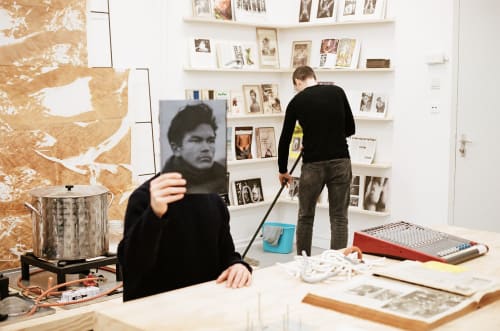WERKER operates at the intersection of labour, ecofeminism, and the LGBTQ+ movements, advocating for an image critique of daily life to analyze what becomes visible and what remains hidden or silenced in different political contexts. The art collective, initiated by Marc Roig Blesa and Rogier Delfos in Amsterdam in 2009, released ten issues of a publication called WERKER MAGAZINE. Since then, WERKER has explored a variety of media, including installation, performance, video, sound, textile, digital publishing, and has also developed community projects, reading groups, cine-clubs, radio podcasts, and publishing workshops.
Taking inspiration from Der Vereinigung der Arbeiter-Fotografen (the association of worker photographers), a group of politicized photo-clubs that emerged in Germany in the 1920s, WERKER follows in the footsteps of the first socialist photography experiments in the USSR, which extended to Europe, the United States, and Japan. Their methods revolved around self-representation, self-publishing, image analysis, collective authorship, and counter-archiving.
Under the name WERKER COLLECTIVE, they engage in producing media from below with students, cultural workers, self-organized unions of domestic workers, undocumented migrants, in support of anti-eviction activists, feminist groups, LGBTQ+ communities, and people with neurological or functional diversities. Through these workshops, WERKER COLLECTIVE weaves an intersectional and transnational network of allies, reactivating oppressed histories, and investigating worker's solidarity through collaborative artistic practice.
By practicing counter-archiving, WERKER aims to preserve and disseminate the legacy of self-organized radical documentary practices. WERKER collects documents and visual materials from second-hand bookstores and flea markets, donated by friends and comrades, or produced during the collective's artistic and activist collaborations. The archive is physically located in the Nieuwmarkt neighborhood of Amsterdam and comprises over 3000 historical and contemporary documents, such as (photo-)books, posters, pamphlets, movies, textiles, and paraphernalia. It is regularly activated through workshops, performances, installations, and publications. By 'reactivating the archive,' WERKER enables the production of emancipatory political imagination through self-publishing and collective study.
WERKER understands artworks to be interdependent and circumstantial to their place of creation, production methods, and presentation venues. Thus, it operates contextually, exploring different spaces, modes of production, and distribution of art and alternative media.
Since its foundation, WERKER COLLECTIVE has collaborated with numerous artists, activists, researchers, and unions on various projects in schools, museums, and archives. These collaborations form WERKER's ecosystem, including Activestills, Ariella Aïsha Azoulay, Casco Art Institute: Working for The Commons, Centre Culturel Populaire Palentes Orchamp (Groupes Medvedkine), Centro de Arte 2 de Mayo, Der Arbeiter-Fotograf, Dutch Art Institute, Georgy Mamedov, International Institute of Social History, Jo Spence Memorial Archive, Manifesta 14, Silvia Federici, Mayday Rooms, Mokum Kraakt, Museu d’Art Contemporani de Barcelona, Niet te Koop, Photography Workshop, Rijksakademie van Beelende Kunsten, Sindillar: Sindicato de Trabajadoras del Hogar y los Cuidados, Susoespai: Creació i Salut Mental, Stedelijk Museum, Steve Edwards, Sonsbeek 20–24, Tate Modern, The Showroom, The Voice of Domestic Workers, and We Are Here.

